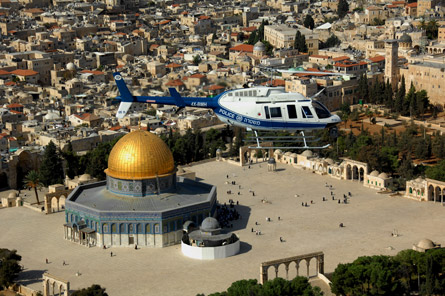Symbolism attaches to the heavy steel door that allows you to enter a security-check building: the Israeli police air unit is unique, and the circumstances that make it so different explain not just the reinforced barrier but also the uniformed policeman with a short M-16 assault rifle who checked my identification for long minutes.
 |
|---|
| Israeli Police Three Bell 206L LongRangers make up part of the six-helicopter fleet |
After I am allowed to get into the base somewhere in central Israel, I find a professional unit working around the clock to assist the Israeli police and other security bodies.
The situation in Israel is strange. Rescue missions of, for example, people who fall into creeks in the desert are performed by the Israeli air force's 669 unit. The Israeli "Red Magen David" first-aid organisation operates helicopters for transferring the wounded to hospitals. The police air unit performs police missions as traffic control, fighting crime and helping to keep the order in public events - but the unit is also active in the daily fight against terror.
Cdr Nir Rosenthal, the unit's chief, is happy to describe the unit operations in pure police-mission terms. When it comes to anti-terror operations, he chooses his words carefully: "I'm happy to say that we see a decrease in the number of anti-terror missions, but we are always ready."
The unit operates three Bell 206L LongRanger and three Bell 206B JetRanger helicopters. The unit has one fixed-wing light aircraft.
Israel is a small country, so the unit is assisting police units everywhere and is co-ordinated by the police operations branch at police headquarters in Jerusalem.
The helicopters are equipped with Controp day/night electro-optical payloads, with a powerful "Night Scanner" search light and a substantial PA system. Video is transferred to mobile and fixed command centres on the ground.
What characterises anti-terror operations? "In the past, we acted upon solid intelligence to foil attacks on civilian targets and we also took part in stopping the terrorists," says Rosenthal. An attempt to find out more about this side of the unit's operations is answered with big smiles and silence.
The unit's pilots are not training. That does not affect their flying capabilities, for a simple reason: they all come from the air force and keep training in their respective squadrons, as they are very often called for reserve duty.
The current fleet answers operational needs, but Rosenthal would like to have newer helicopters with much more powerful engines. His wish list becomes clear as he shows me brochures of two potential candidates: the Eurocopter AS350 and its EC120. While it seems that the plans will stay on paper for a while, due to budget restraints, the Bell 407 is also being looked at.
Israel is a world power in unmanned air systems. Has Rosenthal considered using these platforms for police missions? The commander reveals that Elbit Systems' SkyLark 1, used by the infantry units of the Israel Defence Forces, was evaluated. "We found out that it does not answer our needs," he says. "But we are looking for some unmanned system."
UNMANNED POTENTIAL
Rosenthal says he prefers a larger UAS, not a "personal" one that gives the soldiers "behind the hill" capability: "We think that for our needs we will prefer a larger UAS operated from a base and with the capability to transmit real-time video to anywhere it is needed."
The Israeli UAS manufacturers see the air unit of the Israeli police as a good potential customer, and there is no doubt that some other systems will be evaluated soon.
 |
|---|
| Israeli Police The unit's duties including supporting ground units to control traffic and combat crime |
But there is a problem, unique to the Israeli police's UAS operations. While the defence forces and air force operate their UASs mostly over open areas, the police will use them over populated areas. "This will increase the price of a flight hour dramatically as we will have to pay for insurance in case a civilian is hurt," says Rosenthal.
Israeli airspace is very small and very congested. The unit has to co-ordinate each mission with the air force, which rules the skies over Israel. "We get full co-operation from the air force, and that does not limit our operational freedom," he says.
The unit is on alert 24/7 and is located at three bases: one central, one in the north and one in the south. Scramble time is 15min, and thanks to the three locations, the helicopters can get to any spot in 10min from take-off.
Rosenthal refers to his pilots as "fighters". He argues that this is the right term because "first they are fighters, and then pilots".
The pilots carry side arms, but this is not Rosenthal's reason for referring to them as "fighters": he says only that "they are field operators and that makes them fighters".
When I take out my camera to take some pictures of one of the Bell 206s taking off, the security officer escorting me insists that I shoot only in a certain direction. Some "items" in the area of the helipad make him restless, and I have to follow his orders. Before we leave the helipad, he deletes one of the images from my camera. This is is another reminder that this is not a regular police air unit.
The unit conducts about 2,000 missions per year, and the helicopters are in the air for about 3,000 hours in that time.
The Israeli police air unit will expand in the coming years. The missions it performs are crucial to routine police work - but also to the ability of the police to foil terror acts.
Source: Flight International























